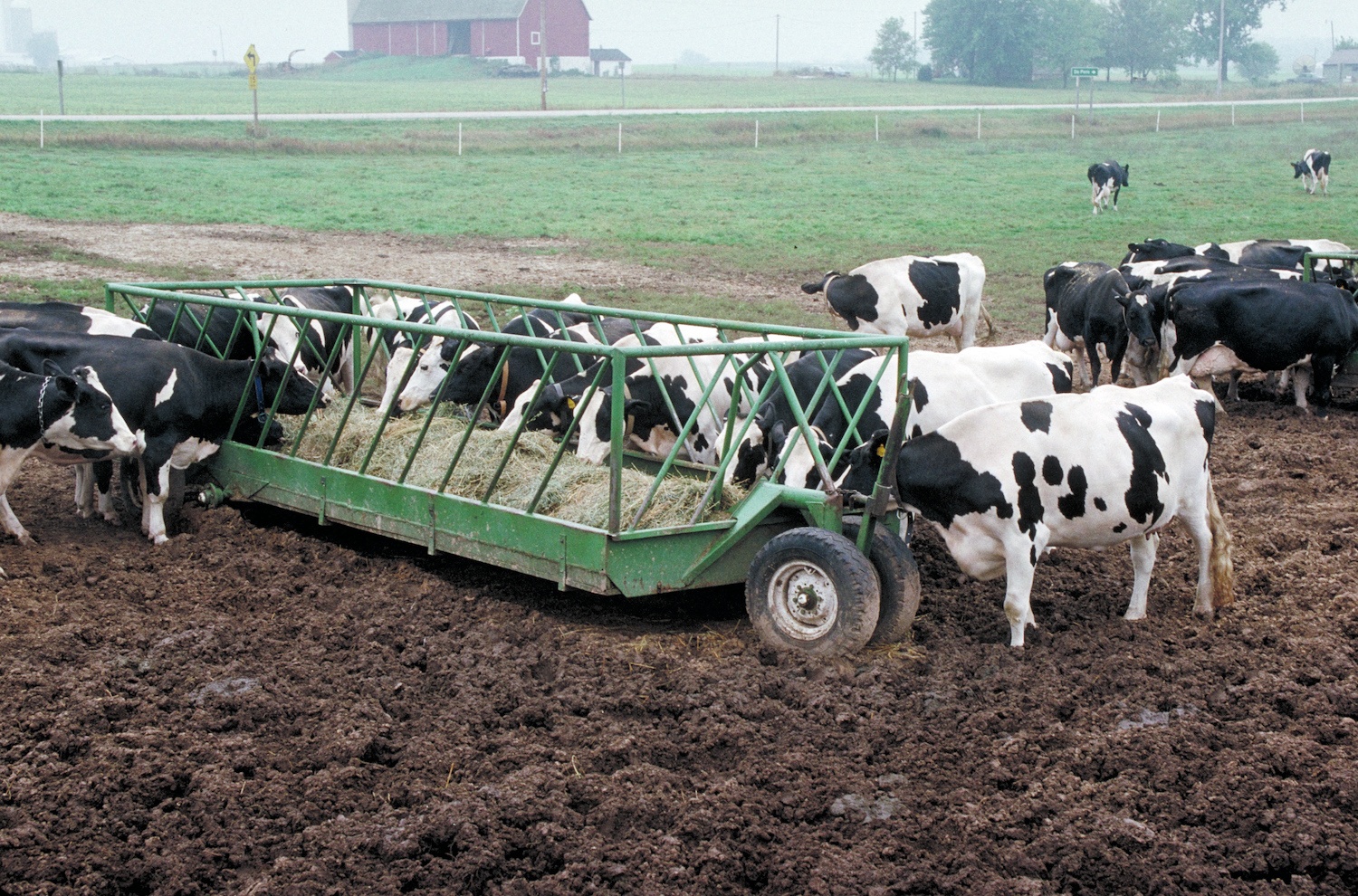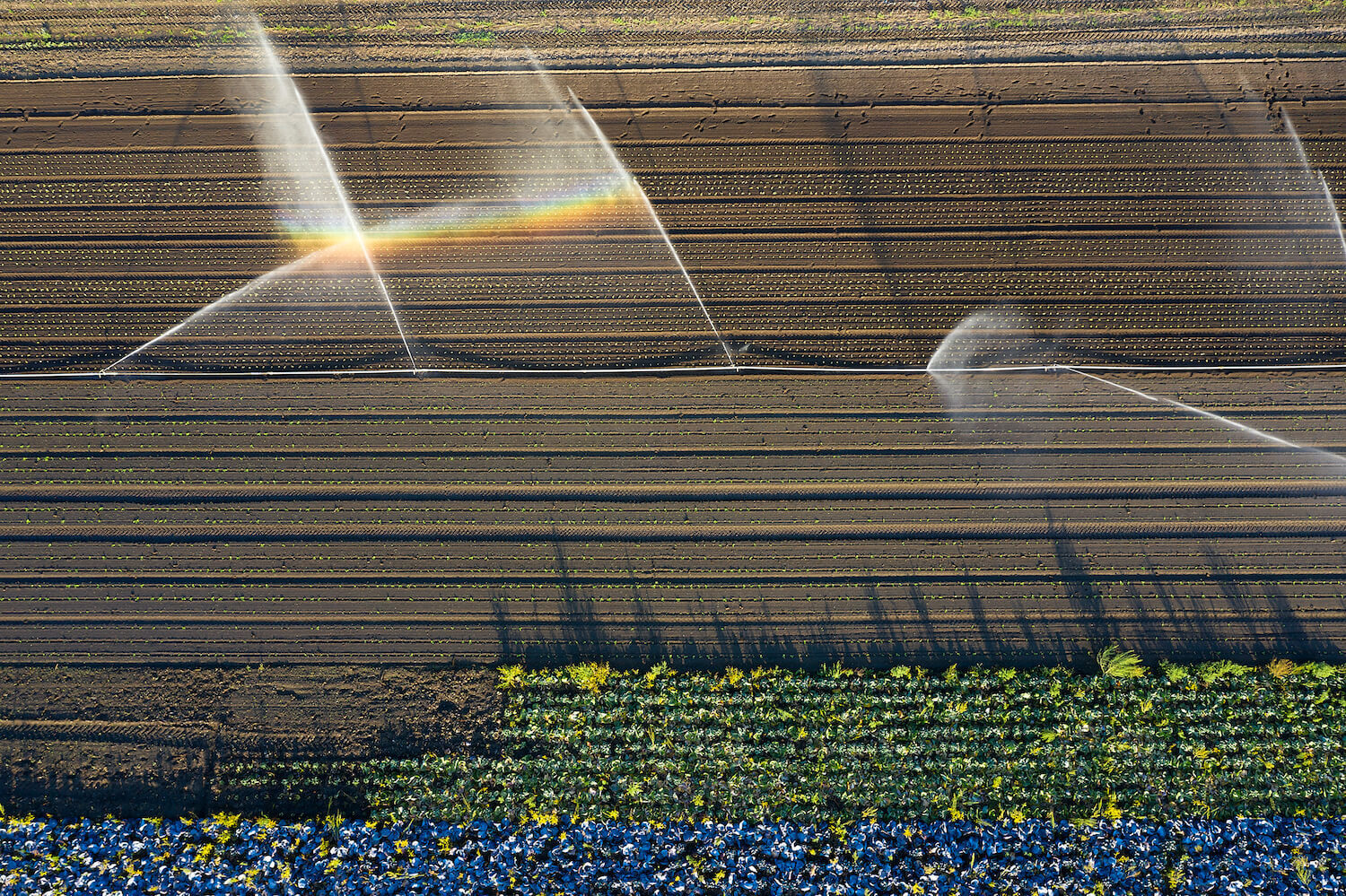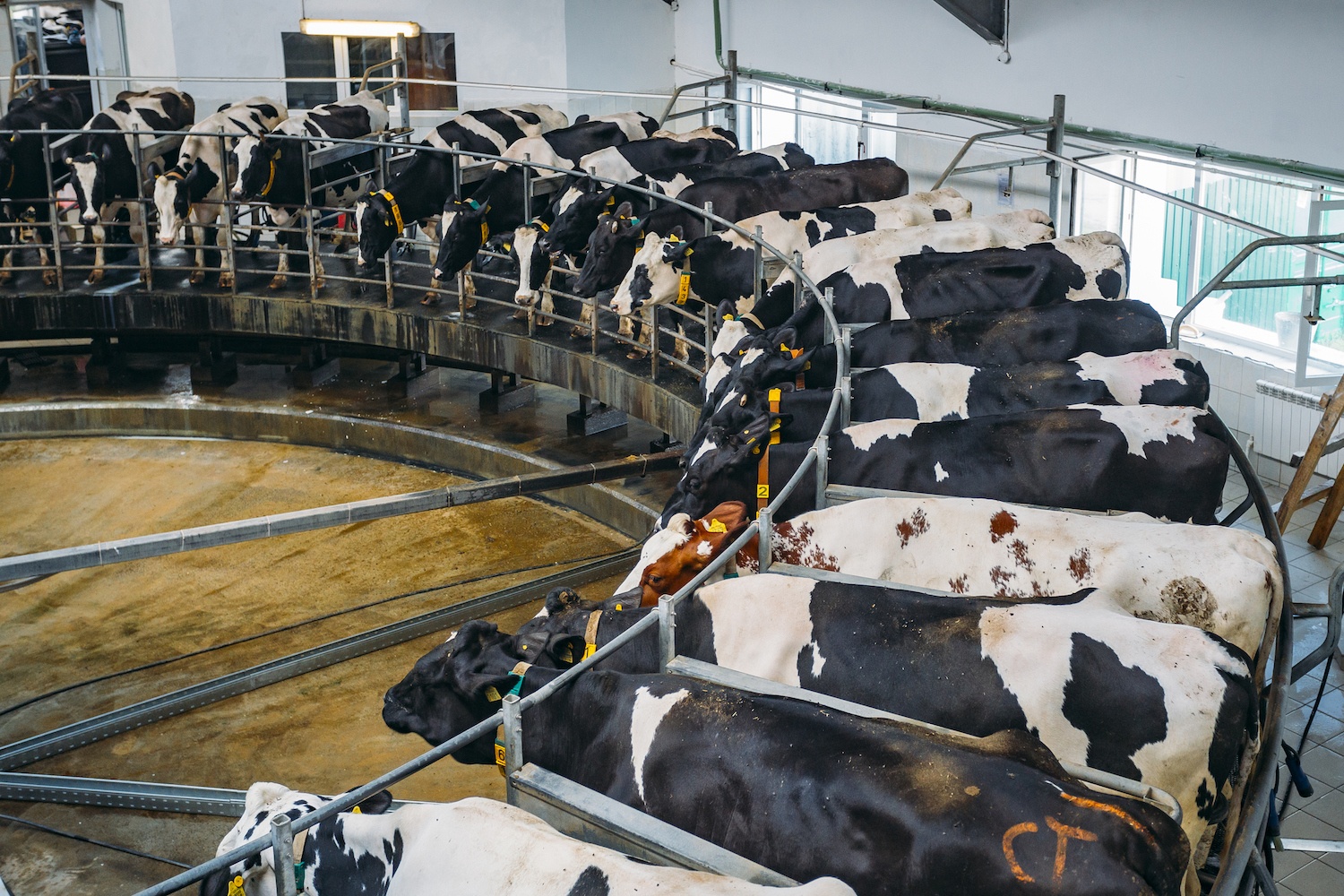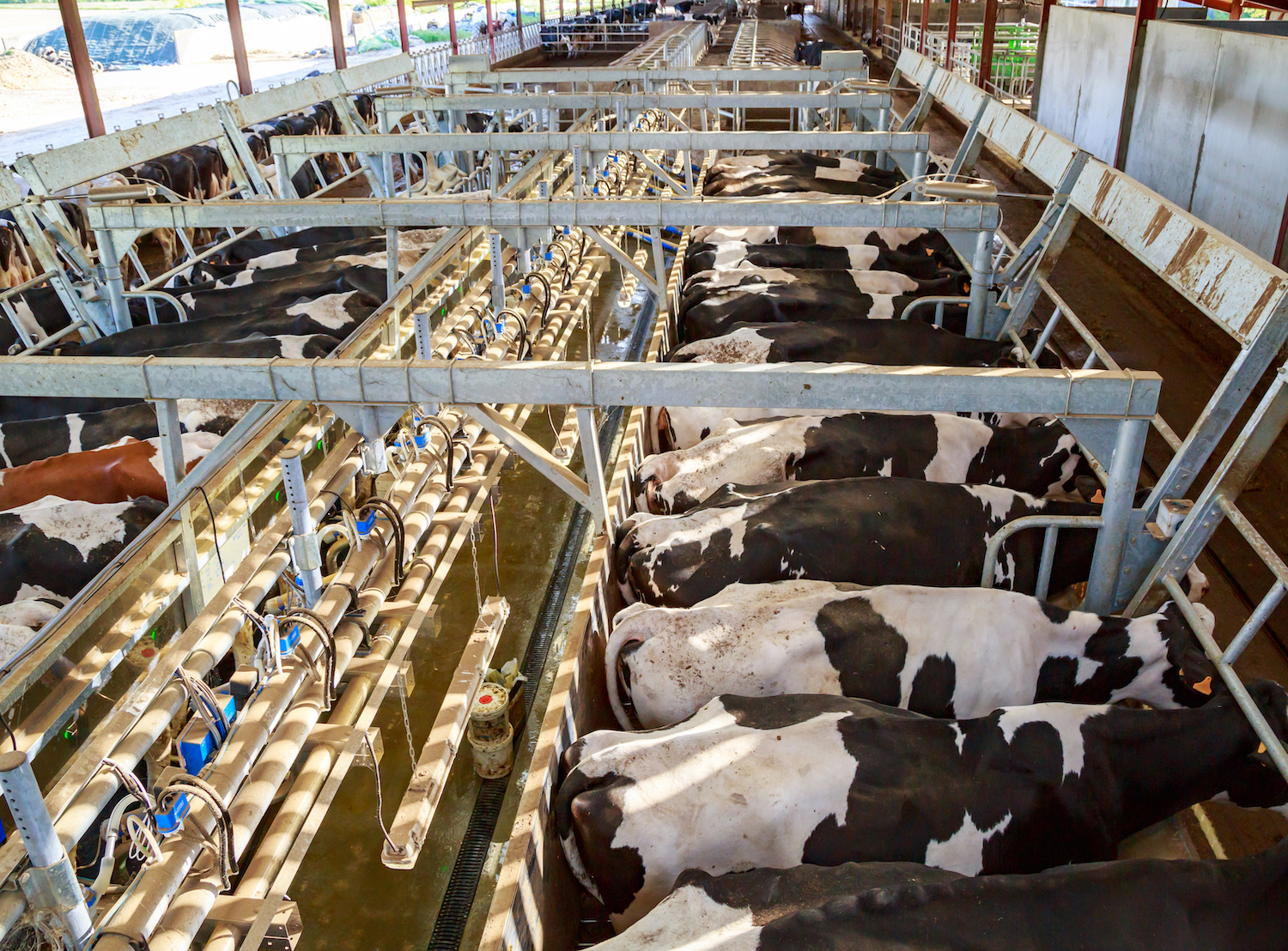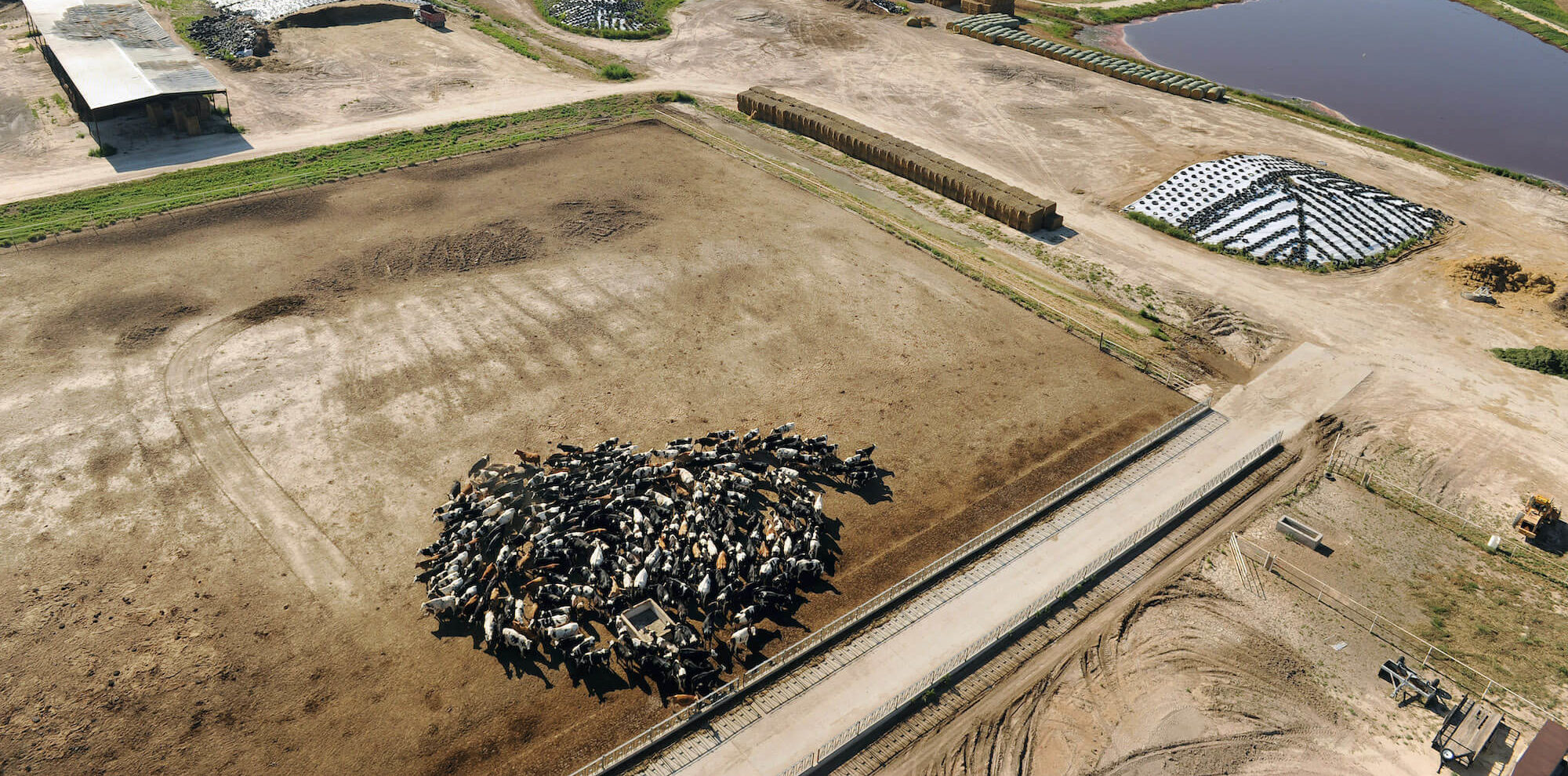
Matt McClain/The Washington Post via Getty Images
Minnesota’s Riverview Dairy has deep pockets and long straws.
In the winter of 2018, Lauralynn Cornelsen moved out of her mobile home in Sunizona, an unincorporated community in southeast Arizona. After more than six years, she was tired of hauling water for drinking and bathing, and she couldn’t afford to drill a well — certainly not one deep enough to survive the impending squeeze once a nearby mega-dairy began to operate.
Cornelsen’s story epitomizes the challenges local residents are facing over the ongoing water crisis in this rural community, a problem that worsens every year and that no person or agency has figured out how to solve. She is one of hundreds of people, mostly low- to middle-income, living in a high-desert landscape whose groundwater is rapidly disappearing as water is pumped to grow alfalfa, corn, nuts, wheat and barley.
Note: This story was updated to correct Lauralynn Cornelsen’s name.
But the greatest pressure on the region’s aquifer comes from Riverview LLP, a Minnesota-based dairy company whose groundwater pumping is seen by many as the primary cause of their drying wells.
Far away in Kerkhoven, Minnesota, farmers Jim and LeeAnn VanDerPol have watched as their community lost many of its residents following decades of shrinking agricultural margins and increased corporate consolidation in the livestock sectors. Their former neighbors have been replaced by the five huge Riverview facilities within 10 miles of their house. In Chokio, Minnesota, about an hour away, locals successfully fought to keep Riverview from building a 9,200-cow dairy, citing concerns about pollution and groundwater decline.
Smaller dairy farmers nationwide have weathered years of milk prices below the cost of production that culminated in an industry-wide economic crisis. Now they face a new adversary: mega-dairies.
Smaller dairy farmers nationwide have weathered years of milk prices below the cost of production that culminated in an industry-wide economic crisis. Now they face a new adversary: mega-dairies, or dairy CAFOs (concentrated animal feeding operations). In Franklin, southwest of Minneapolis, James Kanne struggles to hang onto his small family dairy even as mega-dairies like Riverview compete for the few remaining milk processors.
This investigation follows Riverview’s rapid expansion in two of the five states it operates in, linking the environmental and economic consequences — and the lives of those who are impacted.
The people we spoke with in Minnesota and Arizona are 1,500 miles apart, connected only by the ever-growing presence and power of Riverview. But their communities have much in common: The local industry and resources have been monopolized by a deep-pocketed entity. The groundwater is being depleted and polluted. Incessant traffic, dust, lights and the stench of livestock cause home values to plummet and strain the emotional ties locals have to the places they call home.
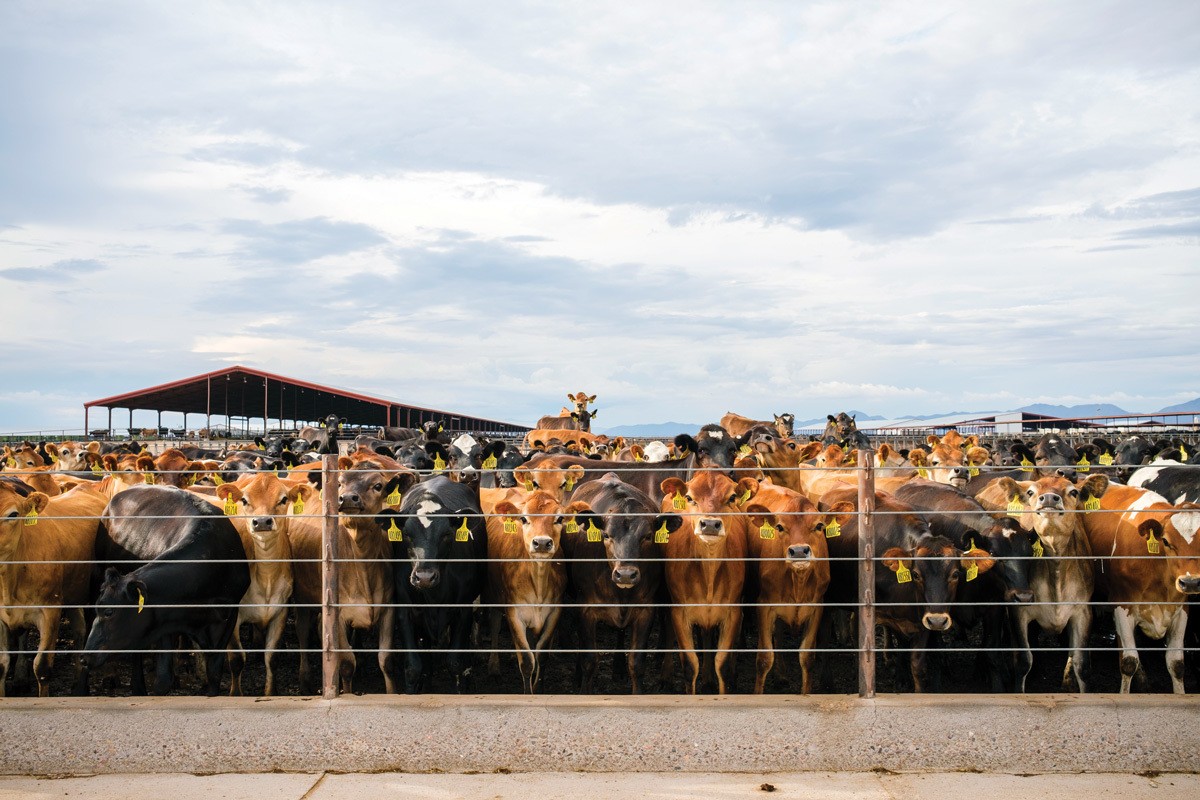
Thousands of dairy cows crowd the Coronado Dairy’s feedlot in the Kansas Settlement area near Sunizona, Arizona.
Roberto (Bear) Guerra/High Country News
SUNIZONA, ARIZONA — On a winter evening in 2020, Lauralynn Cornelsen stood behind the counter of the Days Inn in Willcox, Arizona, where she worked as a desk clerk. Inside the quiet lobby — the walls decorated with paintings of cowboys, the continental breakfast bar closed for the night — she spoke resolutely about the previous decade, during which she had tried desperately to make a life for her family in an increasingly parched landscape.
Cornelsen and her six children moved to Sunizona in 2011 from St. David, about 55 miles away. They needed to find someplace cheap, Cornelsen said, so they bought 2.5 acres for $3,600. “I liked the rural atmosphere, but our main thing was that it was an emergency, and it was inexpensive,” recalled Cornelsen. “It was what we could afford with our tax refund.”
In Sunizona, population 212, tract, manufactured and mobile homes border dirt roads and the state highway that leads to the Chiricahua Mountains. Sunizona has a mini-mall, a café, an elementary school, a laundromat and a couple of churches, but no post office — not even a convenience store.
The Cornelsens first moved two RVs and a van, then a mobile home, onto their land, but the property lacked electricity and had no well. Years later, the family managed to get electricity, but water remained a problem. Almost every day for six years, Cornelsen and her children walked to a church a mile and a half away, where they, and 12 other families, filled 1-gallon jugs with water from a hose.
“It was a real hassle, but you gotta do what you had to do,” Cornelsen said. “I had kids and I had to make sure they were watered.”
The family wanted their own well. But it wouldn’t be cheap: Cornelsen said the well drillers told her it would cost about $40,000. Water was already scarce and demand was growing: Riverview would soon begin construction on Turkey Creek Dairy, its second dairy in Arizona, just down the road, and it would be drilling deep, she said.
“I believe business runs America, and when the big guy is taking a precious resource like water — that I’m against.”
At the time, Cornelsen was earning minimum wage as a home-care aide for elderly and disabled patients. She was living paycheck to paycheck, and far from alone: In 2019, according to the census, Sunizona’s annual median household income was $22,500 — just over 61% of the median household income in Willcox, 30 minutes north, and just 38% of the state’s.
Cornelsen could not afford a new well. She was also worried about the new mega-dairy and the traffic and other problems she thought it might bring. Ultimately, it was all just too much; she decided to leave. In 2018, she gave the property to a close friend from church and moved to Willcox, where she got the job at the Days Inn. Her new property has two wells.
Though several years have passed since she left Sunizona, Cornelsen is still angry about what happened. She said Riverview sucking up the water was a major factor in driving her and many of her neighbors away. “Too many people are afraid of saying anything,” she said, her voice taking on a passionate edge. “I believe business runs America, and when the big guy is taking a precious resource like water — that I’m against.”
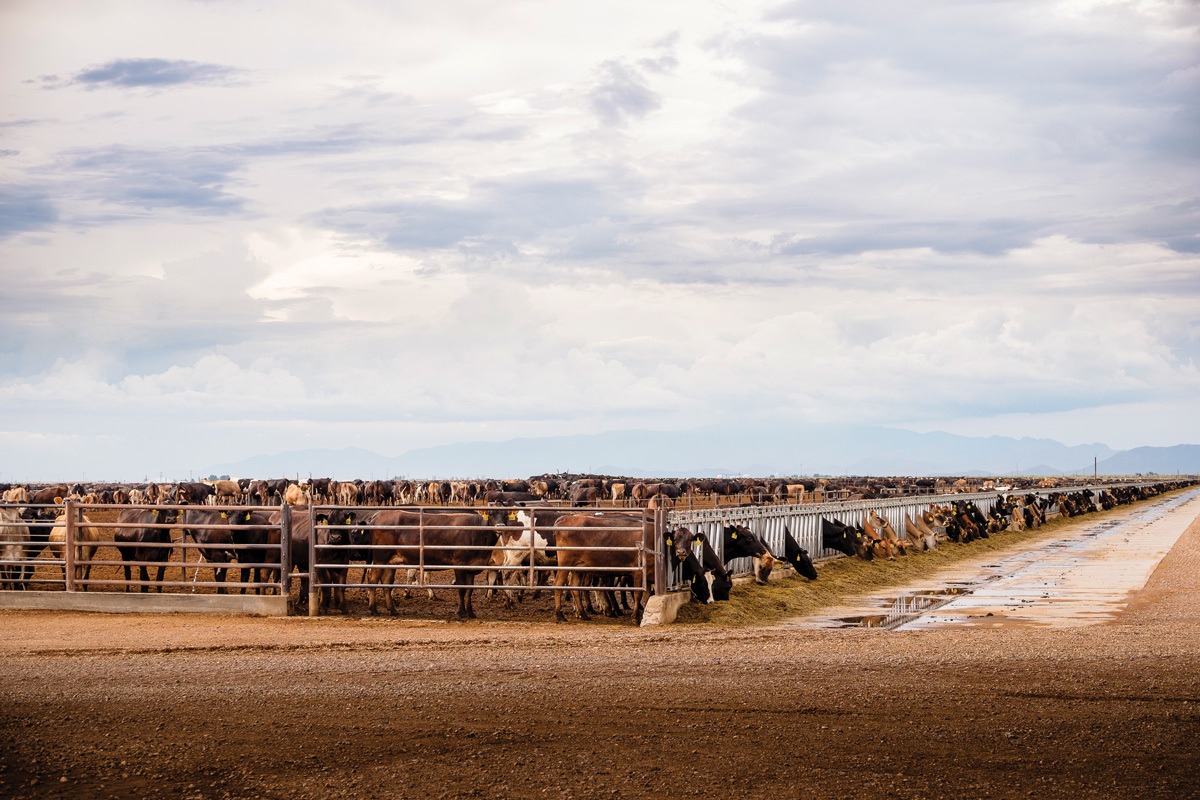
Cows at the Coronado Dairy’s feedlot in the Kansas Settlement area near Sunizona in southeastern Arizona. The feedlot is among the farm properties recently acquired by the Minnesota-based mega-dairy Riverview LLP.
Roberto (Bear) Guerra/High Country News
NOBODY KNOWS HOW MANY WELLS have dried up in Sunizona, let alone the entire Willcox Basin, which covers 1,911 square miles in Arizona’s southeast corner, near the New Mexico border. But between 2014 and 2019, records from the Arizona Department of Water Resources (ADWR) show that around 20 wells in the Sunizona area were deepened after drying up. In the entire basin during that time, records show that 57 wells were deepened, but interviews and anecdotal accounts place the number at more than 100.
While pinning the decline of any individual well on a neighboring well or wells is next to impossible, evidence is mounting that the decline of the underground aquifer here has accelerated since Riverview’s arrival. The company has drilled about 80 wells in the Willcox Basin since January 2015, and added six more in the Douglas Basin, just to the south, since it started buying land there in October 2020. Most of the wells are at least 1,000 feet deep, and three are close to half a mile deep — deeper than any other well in the area. Many of them lie near Sunizona’s barren wells.
Kevin Wulf, a spokesperson for Riverview, acknowledges that the dairy’s water use is a factor, but he insists it’s hardly the only one to blame.
“I get it,” Wulf said as he led reporters on a tour of the dairy in early 2020. “We’re the big target.” Wulf, a clean-cut former elementary school teacher, looked out at the 90-cow milk carousel, which turned slowly like a merry-go-round. “The rumor is: You’re here to suck the valley dry. And then you’re going to leave. We don’t want to do that.”
The company has purchased nearly 51,000 acres in the Willcox and Douglas basins, according to Cochise County land records, spending more than $180 million, nearly all in cash.
In the spring of 2018, Wulf and his wife, who are members of the Apostolic Christian Church in Morris, Minnesota, relocated to Arizona. The Apostolic Christian Church in Tucson had put out a call for new members, and Riverview’s Arizona operations were expanding. The landscape is very different, he said, but “if you’re doing what you know God wants you to do, anywhere is great and can be an awesome place.”
In just a few years, Riverview has utterly transformed the appearance and economy of the Willcox Basin. The company bought out nearly 30 local farmers and easily became the basin’s biggest grower. It employs 200 people in Arizona and has even built on-site housing for the foreign workers among them.
In January 2015, Riverview paid $38 million in cash to buy the Coronado Dairy, a locally owned operation in the Kansas Settlement area, about 10 miles north of Sunizona. It also bought 6,474 acres of surrounding land.
As of publication, the company has purchased nearly 51,000 acres in the Willcox and Douglas basins, according to Cochise County land records, spending more than $180 million, nearly all in cash. Much of the property was existing farmland the dairy company bought to grow feed for its cows.
The Coronado Dairy is now home to 70,000 Jersey-cross heifers, young cows that have not yet lactated. To drive down Kansas Settlement Road is to watch an entire mile of them tick by like a flipbook: honey-brown ears, big doe-eyes, flicking tails. In a barn set back from the road, another 7,000 dairy cows are milked twice daily.
In Arizona, there are no regulations concerning how much water farmers can pump in rural areas.
When night falls, high-powered floodlights illuminate the feedlot. It is the only such lighting in a place known for its dark skies and glittering stars, and members of the local astronomy club say that it has impacted stargazing. When asked about the light pollution, though, Wulf said Riverview uses significantly fewer lights here than it does in the Midwest.
In 2019, the company built the Turkey Creek Dairy, a few miles north of Sunizona. It’s even larger, with 17,000 small white hutches housing calves from 2 to 90 days old. At full capacity, it will hold 9,000 dairy cows and 120,000 heifers.
Riverview’s critics say the Minnesota corporation was drawn here by the same freewheeling political climate that has brought so many pistachio and pecan farmers to the valley from California and other states. In Arizona, there are no regulations concerning how much water farmers can pump in rural areas. The groundwater pumping in five urban areas in the state’s midsection, including Phoenix and Tucson, is controlled and metered under the Arizona Groundwater Management Act, a pioneering state law passed 40 years ago. But that law bypassed rural areas entirely; it doesn’t even require water-use metering.
“The only reason the water tables are dropping is because more entities are pumping — because there are no rules,” Kristine Uhlman, a retired University of Arizona hydrologist, said. “Too many entities have moved in to pump the free water. Take what you want; all you need is the money to drill a well, the deeper the better.”
According to Wulf, however, Riverview didn’t come to Arizona because of the lack of water regulations; it was attracted by the dry climate and the large amount of available farmland. “Because water usage and conservation is important to us, no matter where we’re located, the water use regulation in Willcox was not a determining factor,” he said. “We think about water and talk about water everywhere we’re at.”
MORRIS, MINNESOTA — The sunrise bled orange over the icy Pomme de Terre River and farm fields glittering with new February snow. Inside Riverview LLP’s flagship dairy, 10,000 cows waited for the feed truck. Some curled their long black tongues around the railings of their pens, but mostly they idled quietly, something that Natasha Mortenson — who works in community outreach and education for Riverview — cited as evidence of their contentment.
“Too many entities have moved in to pump the free water. Take what you want; all you need is the money to drill a well, the deeper the better.”
At one end of the barn, pregnant cows stood in isolated birthing pens; a placenta lay in the bedding near one postpartum cow, glistening the red-purple of mammalian birth. In the “nursery,” one still-wet calf, its umbilical cord dangling, wobbled against a worker, who tilted back its small brown head to insert a tube of colostrum that would reach all the way to its stomach.
At just a day old, the calves will be strapped into tiny vests, machine-lifted into a semi-truck, and transported 10 miles away to the company’s calf facility. A few days later, they are trucked more than 1,000 miles to New Mexico (if bound for the beef market) or Arizona (if destined for dairy).
The Riverview company was started by the Fehr family, who began a crop and beef farm in 1939. In 1995, seeing opportunity in the dairy industry, they established their first 800-cow dairy and became an LLP, a status that allowed for multiple owner/investors. One of those investors was the Wulf family, some of whose members attended the same church — the Apostolic Christian Church — and owned a beef cattle operation. In 2012, Riverview officially merged with Wulf Cattle. Today, Riverview has three linked but separate divisions — dairy, beef and crop — and at least 25 facilities across five states: Minnesota, South Dakota, Nebraska, New Mexico and Arizona.
Throughout the Morris dairy, laminated posters remind employees to BE KIND and BE SAFE — referring to animal treatment and workplace safety — and list the company’s core values: Candor, Integrity, Keep it Simple, Spirit of Humility, and Strong Work Ethic. Riverview’s Kevin Wulf said each core value is biblically inspired. “Candor, for example, means being open with one another, not talking about each other, but talking to each other for better understanding,” he said. “Integrity is about doing the right thing. Knowing that God is always watching.”
But Riverview was at the center of a 2019 Milwaukee Journal Sentinel investigation into the trend of U.S. dairy farms abusing the TN visa program by recruiting college-trained Mexican veterinarians for high-skilled jobs as animal scientists — only to give them various low-skilled jobs, such as milking cows or cleaning. And, according to OSHA documents, three of Riverview’s foreign workers have been killed in work-related accidents; in each case, the company was fined for safety violations. (According to Wulf, Riverview has reduced its OSHA-recordable incident rate to 0.98%.)
The Morris dairy alone produces approximately 390,000 pounds of milk per day, enough to fill six tanker trucks.
Mortenson said that the Fehrs were particularly intrigued by dairy operations in the South, which were much larger than traditional Midwestern dairy farms. The Morris dairy alone produces approximately 390,000 pounds of milk per day, enough to fill six tanker trucks. The company said that all of its milk goes to make cheese. “We’re really bullish with the market,” Mortenson said.
In the past four decades, the livestock industry has undergone an enormous transformation. Farms have become larger, more mechanized and more consolidated. In the U.S., a handful of companies produce the vast majority of beef, pork and poultry. For those studying consolidation trends, it seems clear that dairy is next.
Modern U.S. agriculture was hugely influenced by Earl Butz, secretary of Agriculture under Presidents Nixon and Ford, who championed corporate agriculture and export-oriented commodity production. He famously encouraged farmers to “plant fencerow to fencerow” and “get big or get out.”
Donald Trump’s secretary of Agriculture, Sonny Perdue, echoed these sentiments at the 2019 World Dairy Expo in Madison, Wisconsin, a state that lost 10% — more than 800 — of its dairy farms that year. “In America, the big get bigger and the small go out,” said Perdue. “It’s very difficult on economies of scale with the capital needs and all the environmental regulations and everything else today to survive milking 40, 50, 60 or even 100 cows.”
Despite a 55% nationwide decrease in dairy farms between 2002 and 2019, cow numbers have held steady while fluid milk volume has increased, the result of fewer farms operating on larger scales. Between 2012 and 2017, Minnesota lost 1,100 dairy farms. Meanwhile, during those five years, Riverview built three Minnesota mega-dairies, a feedlot in South Dakota, and started calf and dairy operations in New Mexico and Arizona.
“Whether it’s pork or chickens or turkeys in the past, that’s how they all took over.”
At first glance, it seems reckless for a dairy company to expand during a dairy crisis. But experts point to what happened in the hog and poultry industries in the 1990s, saying it’s a tried-and-true strategy to capture the market when it’s depressed.
“Whether it’s pork or chickens or turkeys in the past, that’s how they all took over,” James Kanne, a sixth-generation small dairy farmer in Franklin, Minnesota, said. “They expanded when the market was down. And then when the market came back up, none of the little guys could get back in again.”
And Riverview is not done growing. A crop farmer in Dumont, Minnesota, who asked to remain anonymous because of the small community, said that a Riverview official visited his home and shared plans to build a 24,000-cow dairy one mile away. The official offered to buy the farmer’s corn for feed, and to sell manure to him as fertilizer, but the farmer declined. “I said, ‘I’m not very interested in that, because you’re not paying enough for the product, and you’re charging too much for the manure.’ ”
The farmer was also horrified by the idea of so many cows so close to his home: the odor and air quality, wear and tear on the roads, manure leaching into the streams and rivers, and the demand on the groundwater supply. “It’s scary they’re going to come in here and suck that much water from the ground,” he said.
According to research by Dara Meredith Fedrow, a graduate student at the University of Montana, Riverview used more than 570 million gallons of water in 2017 — about one-quarter of the total consumption by hog and dairy CAFOs in Minnesota.
The Dumont-area farmer also questioned Riverview’s “never-ending supply of money” at a time when so many dairy farmers are going out of business.
The 24,000-cow dairy has not yet been built but, according to state records, the company applied for a permit to build a 10,500-cow dairy approximately 130 miles north of Dumont. Additionally, an application for another 10,500-cow dairy approximately 100 miles east is up for state approval.
“They never seem to stop,” the farmer said.
During the summer of 2014, however, one Minnesota community did fight back, organizing against Baker Dairy, a 9,000-cow operation proposed by Riverview. “I never was one of those that took on a cause and became vocal, but I didn’t have a choice,” said Chokio resident Kathy DeBuhr, who was shocked to learn that the huge dairy would be built just a mile from her house.
Riverview used more than 570 million gallons of water in 2017 — about one-quarter of the total consumption by hog and dairy CAFOs in Minnesota.
DeBuhr had many concerns — milk tankers chewing up the roads, increased dust, air and water pollution, and the strain on the aquifer — but the biggest one was being downwind of so many cows. “I don’t think I would have been able to sell my house.”
The Baker Dairy proposal was slated for an August public hearing before the Citizens’ Board, the decision-making arm of the Minnesota Pollution Control Agency (MPCA). Since 1967, eight members of the public and the MPCA commissioner have been tasked with reviewing industry proposals and determining whether to require additional environmental impact studies.
“No one thought we had a chance at all of influencing the Citizens’ Board,” said DeBuhr.
But Jim Riddle, who served two years on the board, wrote in an op-ed that Riverview’s proposal had multiple unresolved issues. Among other things, it lacked data on how its “massive water drawdown would impact existing crop and livestock farms in the area.” The board voted unanimously to require a full environmental impact statement.
After the EIS was ordered, Riverview withdrew its proposal, and the Baker Dairy was never built. For DeBuhr, the outcome was bittersweet. While it marked a rare win for ordinary people fighting big business, there were consequences for the Citizens’ Board.
“Soon after voting to require an EIS on Riverview, in the dark of night, at the end of a session on a bill unrelated, without any hearings or public debate, the Citizens’ Board was abolished.”
As reported in the Minnesota Star Tribune, Riverview’s Brad Fehr “said the ruling prompted him to spend two weeks airing his concerns” with industry trade groups. In turn, Riddle said, corporate agricultural interests pressured state legislators to eliminate the Citizens’ Board.
“Soon after voting to require an EIS on Riverview, in the dark of night, at the end of a session on a bill unrelated, without any hearings or public debate, the Citizens’ Board was abolished,” Riddle said. “So that told me that Riverview has tremendous political influence over both parties.”
Kevin Wulf said that while the denial of the Baker permit was the catalyst for the elimination of the board, Riverview was “not involved in that pressure or in that process.”
SUNSITES, ARIZONA — At the Sunsites Community Center, 12 miles east of Sunizona, approximately 50 people sat in folding chairs, their eyes trained on Kristine Uhlman, the hydrologist, as she flipped through a PowerPoint presentation. The workshop, in February 2020, was about a topic of intimate concern to attendees: The health and future of the aquifer beneath their feet.
Like most southern Arizona aquifers, the Willcox Basin aquifer is basically a big tub, composed of fill eroded from the surrounding mountain ranges, Ulhman said. With every monsoon storm, the fill material is reworked, carrying finer grains of silts and clays toward the center of the basin, and leaving coarser sands and gravels at the edge.
To explain the aquifer’s rapid decline, Uhlman used an everyday metaphor — a savings account.
“If your water is old, and it’s not being recharged on a regular basis, that’s a savings account,” Uhlman said, scanning the room. “You’re taking water out of a savings account that’s not being recharged with routine input.”
Ideally, your monthly salary recharges your checking account, enabling you to plan with the predictability of a reliable income, she said. This permits a specific kind of spending, including depositing funds into a savings account. But “when you live off your savings account, you manage your money differently,” she said. “Like in retirement, you are always aware that your savings account is nonrenewable, and you spend with care.”
“You’re taking water out of a savings account that’s not being recharged with routine input.”
Surrounded by five mountain ranges, the Willcox Basin’s aquifer amounts to a bountiful savings account. Before large-scale agricultural pumping began around 1940, up to 97 million acre-feet of groundwater was stored there, according to a 2018 ADWR report — enough to supply Tucson, the nearest major city, for 970 years and then some.
The abundant groundwater has long attracted farmers and ranchers, as has the unique composition of the aquifer itself. Unlike most groundwater basins in Arizona and throughout the Southwest, the Willcox Basin’s aquifer is largely fresh below the first, salty 100 feet, said Uhlman. There may be several thousand feet of fresh groundwater underneath.
But between 1940 and 2015, extensive pumping by farmers seriously depleted the savings account of the Willcox Basin, removing 6.2 million acre-feet of groundwater and lowering the aquifer by 200 to 300 feet, the ADWR report said.
The sharpest declines were in the Kansas Settlement area, where Riverview’s Coronado Dairy now lies, although they were recorded before Riverview arrived. No comprehensive analysis of water-level declines has been done since 2015. But a former ADWR official said that the rate of decline appears to have increased since then, to 3 to 5 feet per year in the entire Willcox Basin, compared to 2 to 4 feet per year from 2010 to 2015. The Sunizona area is also seeing significant declines.
In 2015, basin water users pumped about 240,000 acre-feet, about four times more than the aquifer gets in recharge, said Keith Nelson, an ADWR hydrologist who oversaw the department’s 2018 study. Additional wells have since been drilled, so the overdraft could now be bigger, he said.
“Overpumping, or overspending from a savings account, means you don’t give a damn,” Uhlman said. “Or perhaps you have six months to live, and you don’t want anyone to inherit what you worked hard for.”
The overpumping has driven out a few farmers. As Riverview drilled deeper, they feared they’d also have to drill deeper — something they couldn’t afford. So they sold out to the dairy.
For 25 years, Glenn Schmidt farmed cotton and alfalfa on 166 acres, a mile south of Coronado Dairy. Four years ago, he and his wife, Linda, sold the land to the dairy colossus for $1.3 million.
“They were drilling deep wells right beside me,” Schmidt, who is 65, said. “At my age, I didn’t see how I could spend $2 million on new wells and try to compete. I had (a well) that was 600 feet. The rest of them were 400- to 500-feet wells. Theirs are 1,200.”
Before Riverview’s arrival, Schmidt’s profits and yields rose for 10 years after he started planting new cotton varieties. “We weren’t ready to quit,” he said. “We’d just got new equipment. When they started drilling those deep wells, it ruined my dream.” He had imagined renting his farm to his two sons and living off the rent money. But, he said, “The boys had to leave, to go find jobs. One of them landed in Kansas, one in Oregon.”
“At my age, I didn’t see how I could spend $2 million on new wells and try to compete. I had (a well) that was 600 feet. The rest of them were 400- to 500-feet wells. Theirs are 1,200.”
Joe Salvail also felt he had no choice in 2015 but to sell his land after farming alfalfa for 19 years. His well was dropping more than 7 feet a year, and the water level hovered at 480 feet deep. A new well would have cost him $125 per foot. “I knew I was going to have to eventually put in a new well,” he said. “I didn’t have the money to do it.”
Shortly before Salvail sold almost all of his 320 acres to Riverview for just over $1 million, the company drilled a new well just a half-mile north of his land. “They went down 1,300 feet, and they’re pumping 1,800 gallons a minute out of that well now,” he said. “They’re irrigating with (multiple) center pivots pulling water from that well, and I was having trouble to get enough water to irrigate one.”
But Salvail and Schmidt harbor no bitterness. “I’m glad (Riverview) came by,” Salvail said. “It helped me. I have no problems with them. They gave me a decent offer.”
Schmidt said that the sale allowed him to leave before things inevitably became worse. “If they wouldn’t have bought my farm, and they kept drilling the wells, I’d have been out of business,” Schmidt said.
In Arizona, even the farmers who praise Riverview as a good neighbor and job creator say they’re worried because the local economy now depends so heavily on it. John Hart, who farms 10 miles north of the Coronado Dairy, estimates that 70% of the basin’s economy is tied to agriculture, and that Riverview owns one-third of the 60,000 to 70,000 acres farmed in the basin. Riverview is by far the biggest employer in the area.
“It’s kind of like Walmart moving into town,” Richard Searle, a former county supervisor who grows pistachios 15 miles from the Coronado Dairy, said. “If you have 20 farmers and one goes broke, it’s not a huge impact. You have one entity like the dairy, and if they have a problem, it will have a huge economic impact on the valley.”
KERKHOVEN, MINNESOTA — Afternoon sunlight spilled into the living room through a window still ringed in Christmas garlands, across a piano, a smattering of books and the suspender-clad shoulders of Jim VanDerPol. Outside, a few beef cows ambled across a snowy pasture. VanDerPol, 73, grew up in this farmhouse, and returned to it in the 1970s with his wife, LeeAnn. They raised their children here, and then began their own small farm business, Pastures A Plenty, which today sells grass-fed beef and pork to restaurants and customers across Minnesota.
“If you have 20 farmers and one goes broke, it’s not a huge impact. You have one entity like the dairy, and if they have a problem, it will have a huge economic impact on the valley.”
The VanDerPols used to be surrounded by working family farms, but the 1980s farm crisis drove many of them out of business. Then came the ruinous drought of 1988. And the 1990s brought corporate consolidation of the hog industry, which drove prices down to 8 cents a pound. Those years were “a confirmation of my politics,” Jim said. “And I got that from my dad, who always figured that anybody that wore a suit was on the other side (and) they’re all out to get you.”
Today, the VanDerPols can drive for miles in any direction and remember the people who used to live and farm there. “I sometimes think the right way to say it is that there are ghosts in the land,” Jim said. “It’s a lot lonelier than it was.”
The new farm crisis has roiled farmers nationwide, and dairy farmers arguably have been hit the hardest. Yet there are five giant Riverview operations within 10 miles of the VanDerPols’ house and another within 15 miles.
Riverview’s Louriston Dairy, home to 10,000 cows, is just two miles away. The Star Tribune reports that its cows “drink enough water to drain an Olympic-sized swimming pool in just over two days, and produce enough manure to fill one every three days.”
“What impacts people doesn’t count for very much” in our society, Jim said. That makes it hard to fight operations like Riverview. You can point out that people are being pushed out of business, schools are under stress, communities are struggling, he said, “but those are all people arguments, and they get discounted.”
He has more faith in the land itself fighting back. “It seems to me that the thing that’s apt to tear Riverview apart … (is) the need to pay more particular and more individual attention to every square foot of the earth as we’re using it.” One day, he said, we’ll realize that: “No, we can’t milk dairy cows that way, because it costs the earth too much.”
As they sat at their kitchen table, the VanDerPols talked about the tangible and intangible costs of Riverview’s arrival: the loss of neighbors, the still-unknown environmental impacts, and the already-noticeable change to the night sky due to the 24/7 lights from the facilities.
“In the wintertime here, especially when it’s still or quiet, (the stars) are so bright at night … I mean, it just goes on forever,” said Jim. But now, he said, “That place is lit up like a Christmas tree.”
Jim lifted his spoon and paused. “If people looked at the stars more, they’d probably be able to see their way through to some real solutions.”
“I anticipate out of 3,000 dairy farms left in the state, probably over 80% are last generation dairies.”
A few days earlier, a thick fog froze lace-like into the trees as dairy farmers gathered in a pub in Greenwald, Minnesota, population 238. The occasion was a dairy crisis meeting, co-hosted by the Land Stewardship Project (LSP), a nearly 40-year-old nonprofit that promotes sustainable agriculture and an “ethic of stewardship.” Event organizers expected 50 farmers, but nearly 130 showed up.
Every seat was taken, so farmers leaned against a wall hung with paintings of ducks and spilled into an overflow room. They signed postcards asking state legislators to place a moratorium on new dairies with more than 1,000 animal units — “until the water pollution threat posed by these large operations and the price-depressing effects of overproduction are both addressed,” Matthew Sheets, LSP’s farm crisis coordinator, said.
A state bill was introduced in the Minnesota House of Representatives in March 2020, but stalled in committee. If passed, it would have prevented new or expanded dairies with more than 1,000 animal units until June 2024.
The meeting served as a somber eulogy for the family-owned dairies lost in recent years — and a rallying cry on behalf of those still hanging on. Mega-dairies are partly to blame for the industry-wide economic crisis; their massive overproduction of milk has saturated the market, driving down prices well below the cost of production.
Richard Levins, professor emeritus of applied economics at the University of Minnesota, addressed the room in a soft voice. “Unfortunately, the ‘there’s room for everybody’ argument doesn’t work so well in dairy,” he said. “It’s a matter of simple mathematics.” Bringing in a 5,000-cow dairy doesn’t increase the demand for milk, he explained — it simply replaces 50 100-cow dairies. “We’re playing musical chairs.”
Some see the loss of small dairy operations as inevitable. In February 2018, Marin Bozic, a dairy economist at the University of Minnesota, testified before the state agriculture committee on behalf of Minnesota Milk, an industry trade group. “I anticipate out of 3,000 dairy farms left in the state, probably over 80% are last generation dairies,” Bozic said. “We are going to see a number of dairy farmers that are no longer competitive.” He cited Riverview as a “prime example” of a competitive business model.
“That’s like telling a local hardware store to become a Walmart. You can’t do it.”
But expanding isn’t an option for most dairies, Levins said in a phone call. “That’s like telling a local hardware store to become a Walmart. You can’t do it.” The story isn’t about small dairies getting bigger, he said. “It’s about enormous operations coming in and putting everyone else out of business (because) there’s only so much business to go around.”
And communities change when agriculture consolidates, Levins said. It decreases “the economic activity on Main Street. And of course, it decreases the number of people that go to church, go to school, go to the hospital, that sort of thing. So the consolidation in the dairy leads to consolidation in all of those services as well.”
At the meeting, dairy farmer James Kanne described himself as a “survivor,” the last of the dairies still operating from his childhood. He said mega-dairies compete directly with small dairy farmers for the few remaining processors. And while processors charge small dairies to pick up their milk, they pay premiums to mega-dairies that deliver tankers’ worth of product.
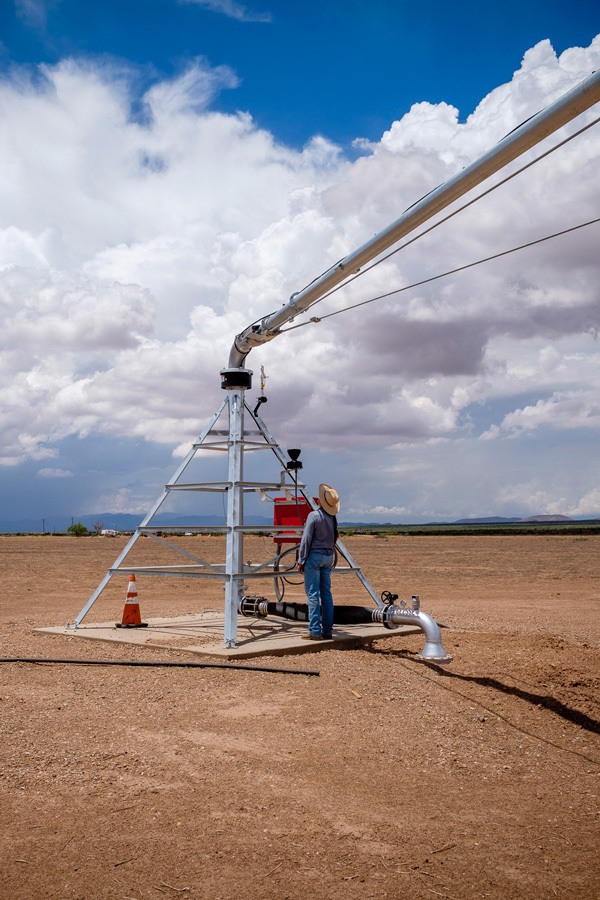
Roberto (Bear) Guerra/High Country News
Anastasia Rabin looks at a new quarter-mile center pivot on land that Riverview recently purchased in Elfrida, Arizona.
Kanne is hanging on, but it’s not easy. His daughter and son-in-law recently returned to the farm to help. “This morning, I was brushing my granddaughter’s hair before she was getting ready to get on the bus, and this evening we will have supper together.” He paused. “And that is what we need. We need family. We need community.”
Heads nodded across the packed room.
AGRICULTURAL WATER USE JUMPED in the Willcox Basin through the 1960s into the middle 1970s, peaking at over 300,000 acre-feet a year. Then, water use crashed through the 1980s and 1990s to as low as 110,000 acre-feet per year, as farming went into a national economic decline. Meanwhile, well levels in the basin fell so far that for many farmers it was no longer economical to pay for pumping.
Starting around 2000, water use started rising again. It hit 172,000 acre-feet by 2014, U.S. Geological Survey statistics show. From 2015 through 2017, the most recent year statistics are available, agricultural water use rose 18.2%, compared to an 8.7% increase from 2012 to 2015.
Riverview’s arrival and land purchases could have been a contributing factor in the increase in water use. Between January 2015 and the end of 2020, 407 new wells were drilled in the basin; 19.6% of these were Riverview’s. The company also inherited hundreds of existing wells through land purchases and now owns nearly 19% of the 799 wells registered in the basin from 2014 through 2019.
Some individual wells in the Kansas Settlement and Sunizona areas have shown some of the worst declines in Arizona, Frank Corkhill, ADWR’s now-retired chief hydrologist, said. One Kansas Settlement well dropped 30 feet between 2015 and 2017, while another dropped 45 feet between 2014 and 2017. Two wells each fell 17 feet in 2017 alone — one in Kansas Settlement and one in Sunizona, Corkhill said.
Southern Arizona’s aquifers lost more than 5.7 million acre-feet of water from 2002 to 2017, with both drought and agricultural pumping playing a role.
Records show that the aquifer has dropped faster since Riverview’s arrival. The Arizona Department of Water Resources monitors 49 “index” wells in the Willcox Basin annually. Of these, 37 declined faster from 2015 to 2020 than from 2010 to 2015, while 12 declined at a slower rate or rose during the more recent period.
At High Country News’ request, Thomas Meixner, the University of Arizona’s hydrology and atmospheric sciences department head, reviewed the index well data and said that, in general, “The decline in water levels appears to be accelerating (since 2015). It’s not uniform. Different wells do behave differently. But on average, they are going down at about 6 feet a year now, compared to a little less than 4 feet in 2015.”
There’s no doubt that the Southwest’s protracted drought, aggravated by climate change, has also played a role, he said.
Altogether, southern Arizona’s aquifers lost more than 5.7 million acre-feet of water from 2002 to 2017, with both drought and agricultural pumping playing a role, according to a study published last November in the journal Water Resources Research.
But since pumping in the Willcox Basin has far exceeded the level of recharge, Meixner suspects that it’s a bigger factor in the decline than drought and climate change.
Riverview, however, said its water use is 25% less than that of the farmers who previously farmed the same land, due to more efficient irrigation methods. The company has installed two types of nozzles on each of its 200 irrigation center-pivots. Wulf said they manually switch them out throughout the growing season. “That takes a lot of work,” he said. “It’s labor-intensive.”
While many farmers who sold to Riverview generally grew one crop per year, Riverview has switched to growing summer and winter crops, boosting its water use.
Riverview works with a third-party hydrologist to monitor its wells to better understand what is happening in the aquifer, he said.
“We recognize the value of water in Arizona and continually search for new innovations to reduce water usage per acre.”
Even so, the company refuses to disclose its actual water use. Wulf calls it “our private business.”
He also said Riverview favors more regulation, including state legislation that would require metering of all rural wells — legislation that so far has gone nowhere.
And some question Riverview’s assertion of a 25% drop in water use. Two longtime farmers in the area, Salvail and Hart, say that while many farmers who sold to Riverview generally grew one crop per year, Riverview has switched to growing summer and winter crops, boosting its water use.
“They’ll put in a wheat crop and follow it with corn,” Hart said. But Riverview isn’t the only grower adding crop cycles; other local farmers are following suit, due to declining crop prices and the increasingly popular practice of “cover-cropping” — planting non-food crops to enhance soil health and prevent erosion, he said.
Many Sunizona residents say Riverview’s conversion of thousands of acres of vacant land to farmland has also boosted its water use. Wulf said that the land Riverview purchased was destined for tree or crop production. “We will continue seeking ways to conserve water on the land we farm,” he said.
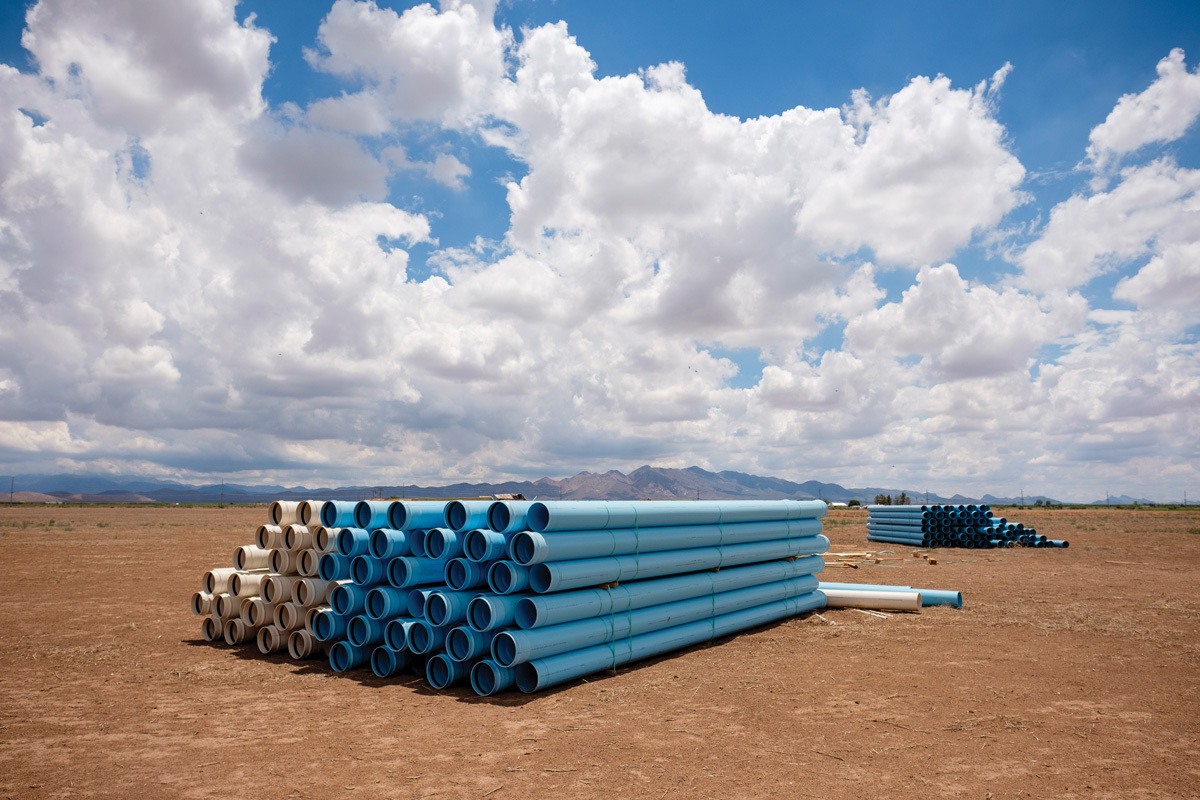
Water pipes are piled near a new pivot irrigation system on land recently acquired by Riverview LLP in Elfrida, Arizona.
Roberto (Bear) Guerra/High Country News
AT A MARCH 2020 GROUNDWATER PRESENTATION in Sunsites, Bruce Babbitt, former Arizona governor and secretary of the Interior under Bill Clinton, was the keynote speaker. He regretted that rural areas, including the Willcox Basin, were left out of the 1980 Groundwater Management Act when it passed under his direction.
The root of that problem lies in the act’s drawn-out, highly complex creation — a process that took years.
“That act didn’t just fall out of the sky. There was as much controversy then as there is now,” Babbitt said.
A groundwater study commission spent three years trying to compromise among the state’s warring mining, farming and urban interests, but got nowhere. In desperation, Babbitt recalled, he gathered seven people representing all factions behind closed doors, where “we met twice a week, went through this line by bloody line, and ended the impasse.”
They split five areas of urbanized central and southern Arizona into state-run active management areas, each with authority to impose conservation rules on residents, businesses and farmers living in the path of urban growth.
Once the group finished with that, “we were so exhausted” that rural areas were left out of the law, Babbitt said.
This was just fine for many rural leaders, including those from the Willcox area, who didn’t want to be regulated. Besides, at the time “rural Arizona didn’t appear to be in any immediate crisis,” Babbitt recalled.
“We thought that eventually, we will authorize ADWR to do the same thing, in rural Arizona. We could not have been more mistaken. The statutes we passed have proven to be unworkable for the rest of the state.”
“That act didn’t just fall out of the sky. There was as much controversy then as there is now.”
The Willcox Basin’s agricultural economy was so volatile for the next three decades that the lack of regulation didn’t seem to matter. But by the middle 2010s, California tree-nut and alfalfa farmers were relocating to the area, and many homeowners’ wells were drying up. In 2014, the state water agency held a public meeting in Willcox, where more than 50 people complained about well problems. At least 40 homeowners completed questionnaires, describing how their wells had dried up or appeared in danger.
A group of farmers, ranchers, rural residents and government officials then formed a working group that spent months producing a carefully negotiated compromise proposal to create a groundwater conservation area for the basin.
Under the plan, those who had pumped groundwater within the last five years would be grandfathered in, while new landowners would face strict limits on future pumping. Most new wells would be reviewed to ensure that they wouldn’t dry up surrounding wells. All well owners would be required to install water meters and report their use to the state. Those using more than 35 gallons per minute would have had to pay an annual fee, to be used for water conservation programs.
But the proposal ruptured the community, dividing neighbors and friends, and it was ignored when it reached the Legislature.
“Today there is not much consensus to do anything,” Hart, the farmer, said. “The guys leading that effort in 2015 got so beat up among their peers, nobody wants to talk about it anymore. If anything is going to happen on the water issue, it has to come from the state.”
Kevin Wulf agrees. “We support state regulation,” he said in a phone call. “We feel like it is more fact-based and less emotional. We feel like if everyone is reporting water usage, we would have a lot more accurate picture of what is happening around water.”
When Babbitt spoke in Sunsites last March, however, he urged the Legislature to give county governments authority to develop their own water management plans.
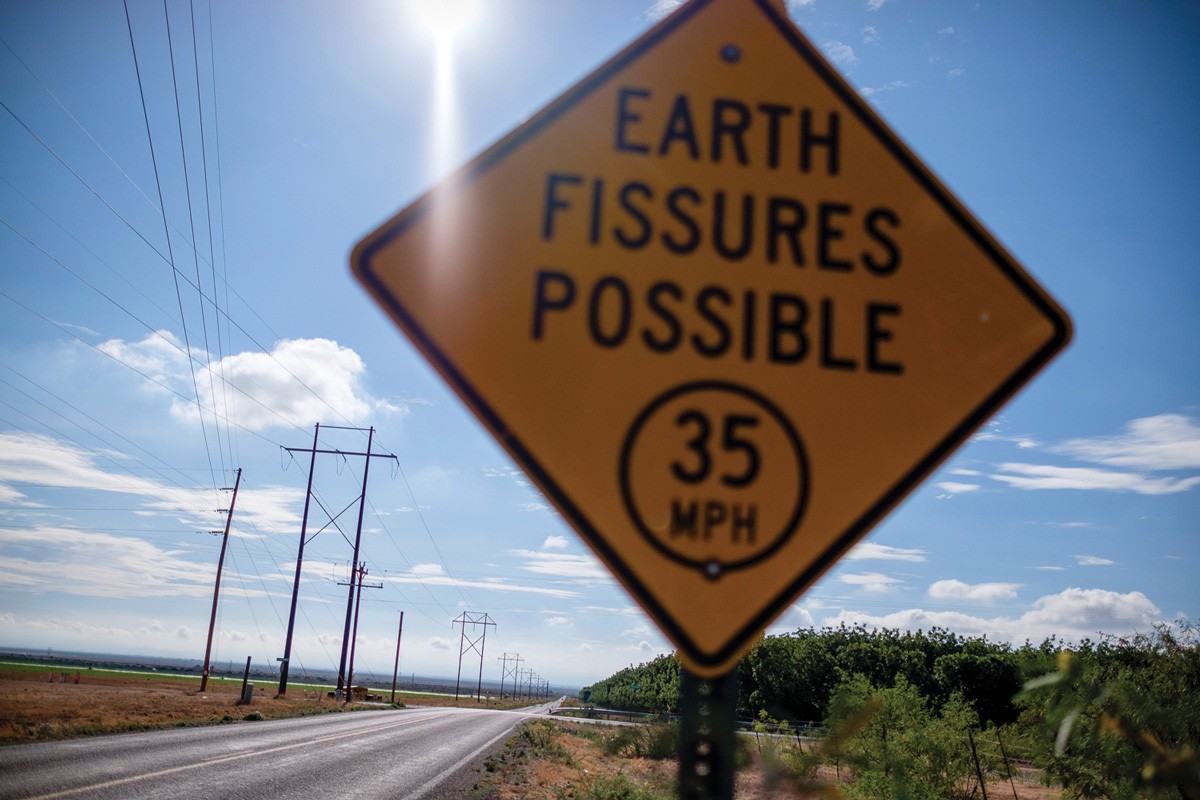
A sign in southeast Arizona warns of the deep crevasses that can occur as the water table drops.
Roberto (Bear) Guerra/High Country News
While the 1980 Groundwater Act was a top-down mandate, “most of the things we do in this state, in this country, in communities, start the other way,” Babbitt said. “We tend to address problems from local governments on upward, to try to find consensus and a path forward. It’s your future, your community, your economy and your neighbors.”
But in both 2020 and 2021, Arizona’s Legislature not only spurned bills like those that Babbitt suggested; it even refused to grant them committee hearings. The same fate awaited bills that would have required water metering in rural areas or made it easier for the state to close off a water-imperiled area to new farmers.
The water forum at which Babbitt spoke was organized by Peggy Judd, a Cochise County supervisor representing the Willcox Basin. Judd, a longtime supporter of Riverview who lauds its economic benefits, opposed new regulations for years, calling them an intrusion on property rights. She now supports them, because the well declines are growing more severe.
“The individual family farmers who originally homesteaded the land — they can only go as deep as their pocketbooks.”
She has formed a new working group to hammer out a water plan behind closed doors. Meanwhile, three Sunizona residents who have had to haul water or else deepen their wells are trying to form a water district to tax homeowners to pay for a well system for the community.
For now, though, the water outlook for the area where Riverview operates is gloomy at best. According to ADWR’s 2018 groundwater study, which is based on a computer model, up to 24 million acre-feet of water will be pumped out of the entire basin by 2115, and water levels could fall by as much as 917 feet in the Kansas Settlement area from 1940 to 2115. Even though as much as 78 million acre-feet may remain, much of it will be so deep that it may not be practical to remove it.
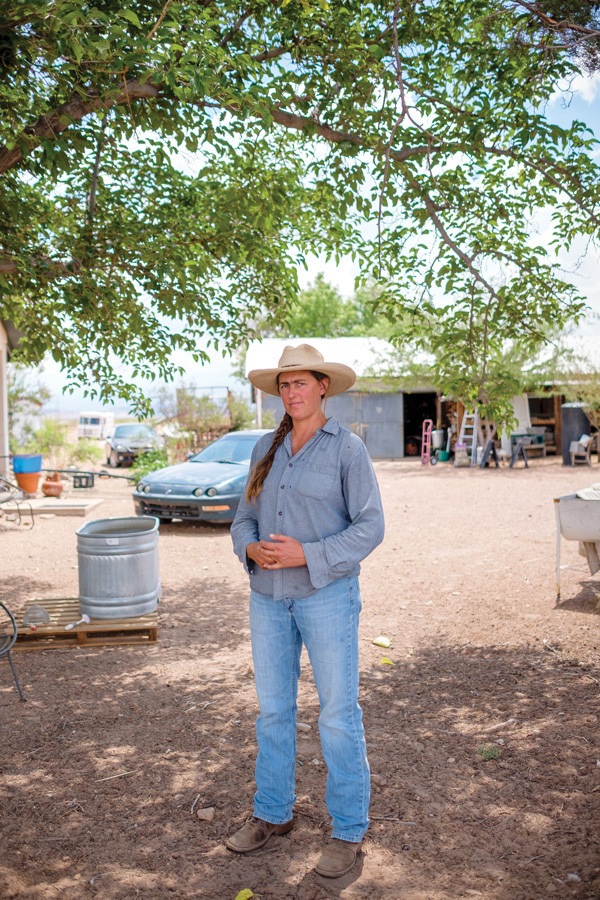
Roberto (Bear) Guerra/High Country News
Anastasia Rabin lives in Elfrida, Arizona, where her farm is now almost completely surrounded by Riverview LLP-owned properties.
Big farmers like Riverview will be able to get water for a long time because they have the money to keep drilling deeper, Uhlman, the hydrologist, said. Homeowners and smaller farmers won’t be as fortunate.
“These companies have the deep pockets to have longer straws that go down deeper in the aquifer,” she said. “The individual family farmers who originally homesteaded the land — they can only go as deep as their pocketbooks.”
ELFRIDA, ARIZONA — In May 2021, a rare storm obscured the Dragoon Mountains behind a wall of rain. After a year of scant precipitation — just 8.35 inches of rainfall in Willcox in 2020, compared to 12.18 inches in an average year — the roadside grass remained golden-brown.
Thirty miles southwest of Riverview’s Coronado Dairy, Anastasia Rabin stood in the yard next to her small herd of goats and scanned the horizon. She has lived in Elfrida for nearly a decade, and watched as industrial farming appeared in the valley. First it was corn, then the California-owned nut operations — and now, Riverview.
In late October 2020, Riverview purchased its first Elfrida property — nearly 4,700 acres for $20 million. Since then, Riverview has amassed a total of just over 9,100 Elfrida acres for close to $36 million. Kevin Wulf said Riverview plans to farm corn and wheat to feed its cows, but “there are no current plans to build a third dairy in the Elfrida area.”
A few months ago, Rabin started noticing land-use changes in the immediate area. Many neighboring farms have sold to new operations, most recently Riverview. The dairy now owns the grain bins towering in the distance and the gravel quarry next door. Across the road, newly assembled irrigation pipes sprawled across one of Riverview’s recently purchased fields. When Rabin looks west across the valley, she can see a flurry of activity: mesquite cleared, wells drilled, pivots installed and fields scraped bare. Loose sand and dirt have been pushed into enormous piles.
“This is desertification in action.”
Recently, Rabin woke to a dust storm. She stood in her yard and took a phone video of a wall of dust so thick that it blocked the mesquite trees and mountains. “This spring, the dust storms were a full-scale natural disaster,” Rabin said, adding that such storms have become more frequent since the arrival of larger farms and the massive land clearing. She kicked at the ground, covered in several inches of beach-like sand, whorled in patterns by the wind. In some places on her property, as much as two feet of sand has accumulated.
“This is desertification in action,” Rabin said — the transformation of a once-biologically diverse landscape into a hotter, drier and much less hospitable environment.
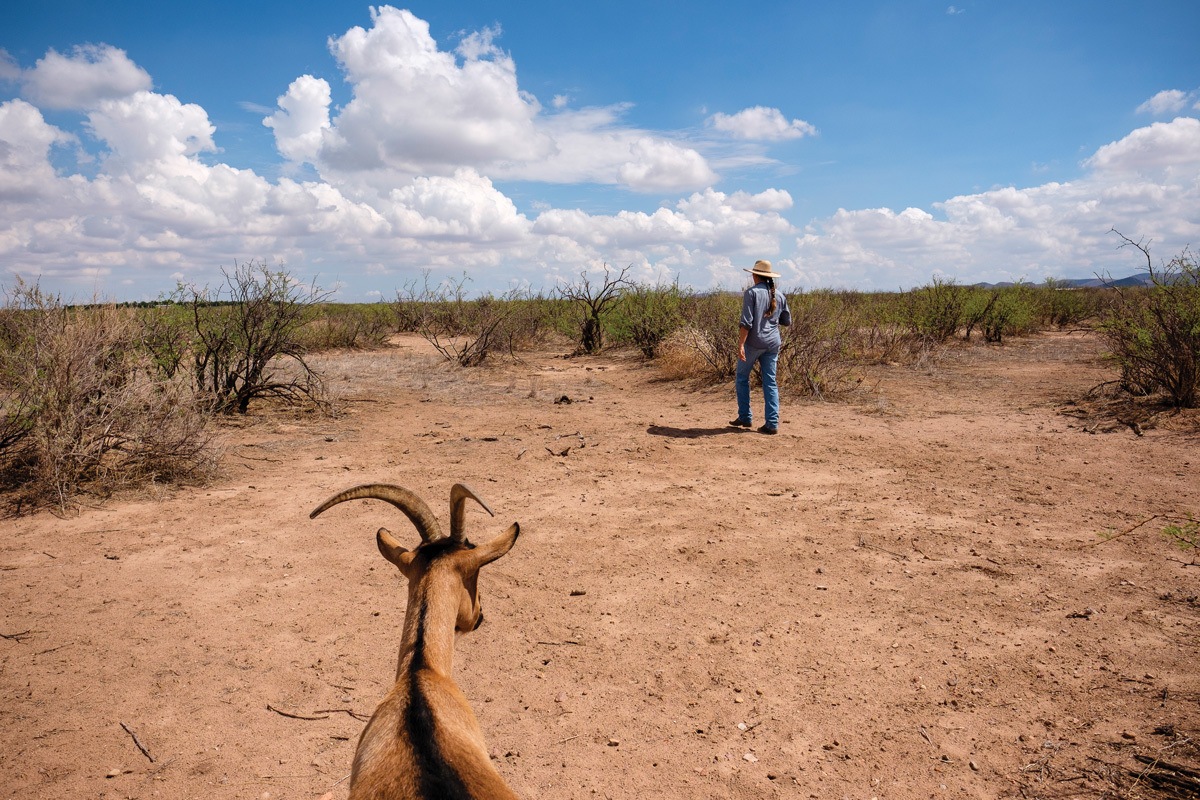
Anastasia Rabin walks through a section of her property that she said has been desertifying even more rapidly since the arrival of industrial agriculture in the area.
Roberto (Bear) Guerra/High Country News
KRISTINE UHLMAN RECALLED that after she gave her water talk in Sunsites, Gary Fehr, Riverview’s board president, left her a phone message. He said that Riverview has a 30-year investment in the area and wondered if the water would run out sooner than that.
“I told him no; as long as you have the money to keep the deep wells, you won’t run out of water,” Uhlman said.
Wulf, however, said that Fehr was asking about the current wells that Riverview is replacing, not hinting that the company would leave the area in 30 years. “The new wells we are drilling today will likely have a similar 30-year lifespan, which prompted the question,” Wulf said.
Wulf insists that in both Arizona and Minnesota, Riverview “wants to be good neighbors.”
“Whether it’s groundwater in Arizona, or freshwater that’s being compromised, or our roads being abused … it’s a matter of the cost being put onto people who don’t even realize they’re paying the price.”
“We sit at kitchen tables at every single neighbor’s house,” Riverview’s Natasha Mortenson said. “We do community meetings and allow people to come ask questions. We feed people burgers and have a sit-down. Does that mean that every single neighbor loves us? No, it does not mean that. But that’s life.”
But dairy farmer James Kanne said that Arizona and Minnesota are connected by a set of hidden costs, imposed by Riverview. “Whether it’s groundwater in Arizona, or freshwater that’s being compromised, or our roads being abused … it’s a matter of the cost being put onto people who don’t even realize they’re paying the price,” he said. “It’s a very insidious way of doing business.”
In both places, residents are pleading with state and local officials to do something — enact groundwater pumping restrictions, or place a moratorium on large livestock operations. So far, though, no one appears to be listening.
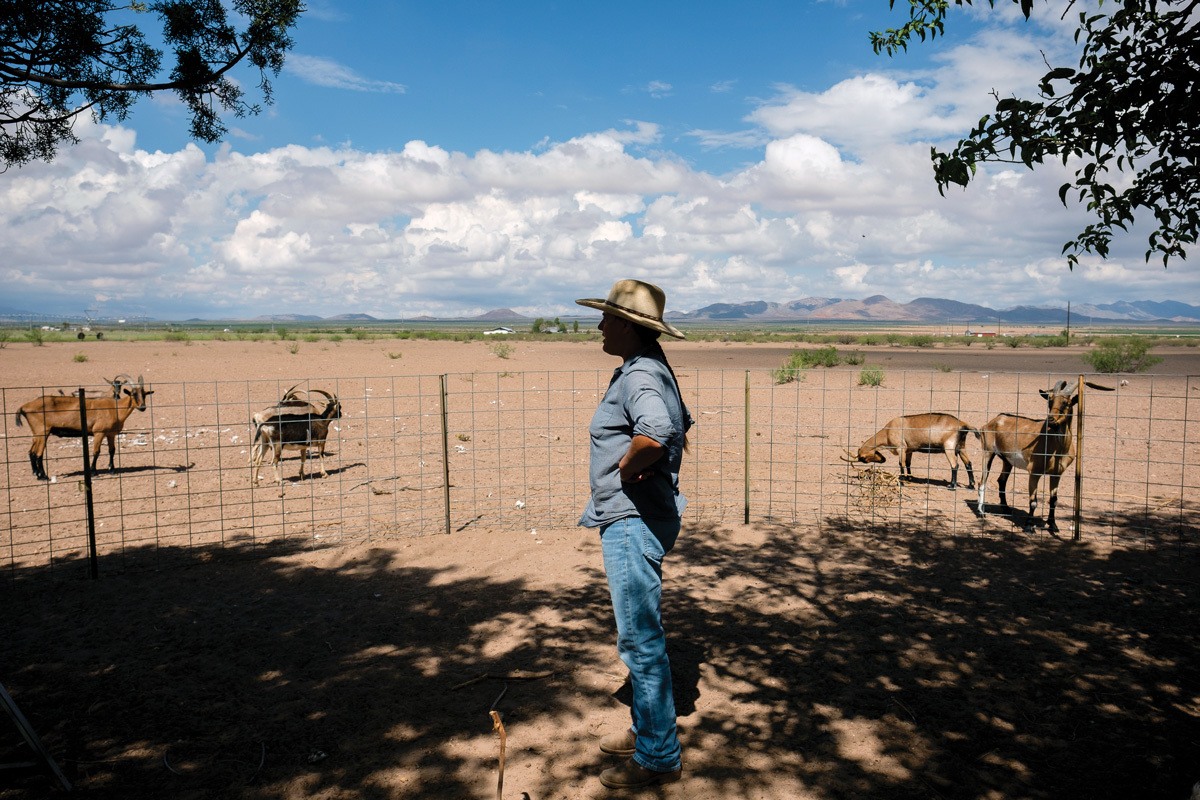
Anastasia Rabin on her small farm in Elfrida, Arizona, where recent dust storms have left deposits of beach-like sand up to two feet deep.
Roberto (Bear) Guerra/High Country News
This coverage was supported by contributors to the High Country News Research Fund and by the Economic Hardship Reporting Project.


